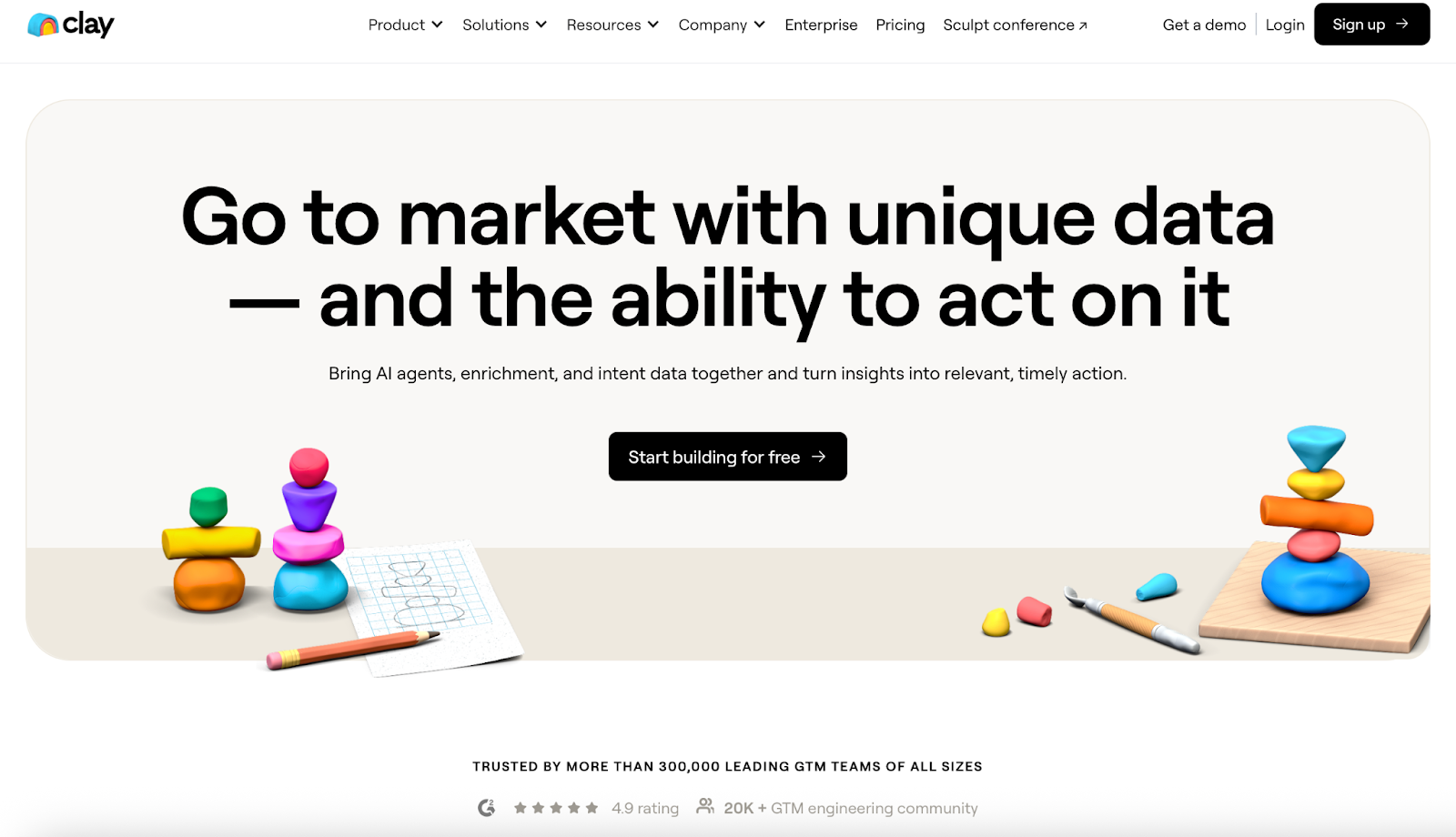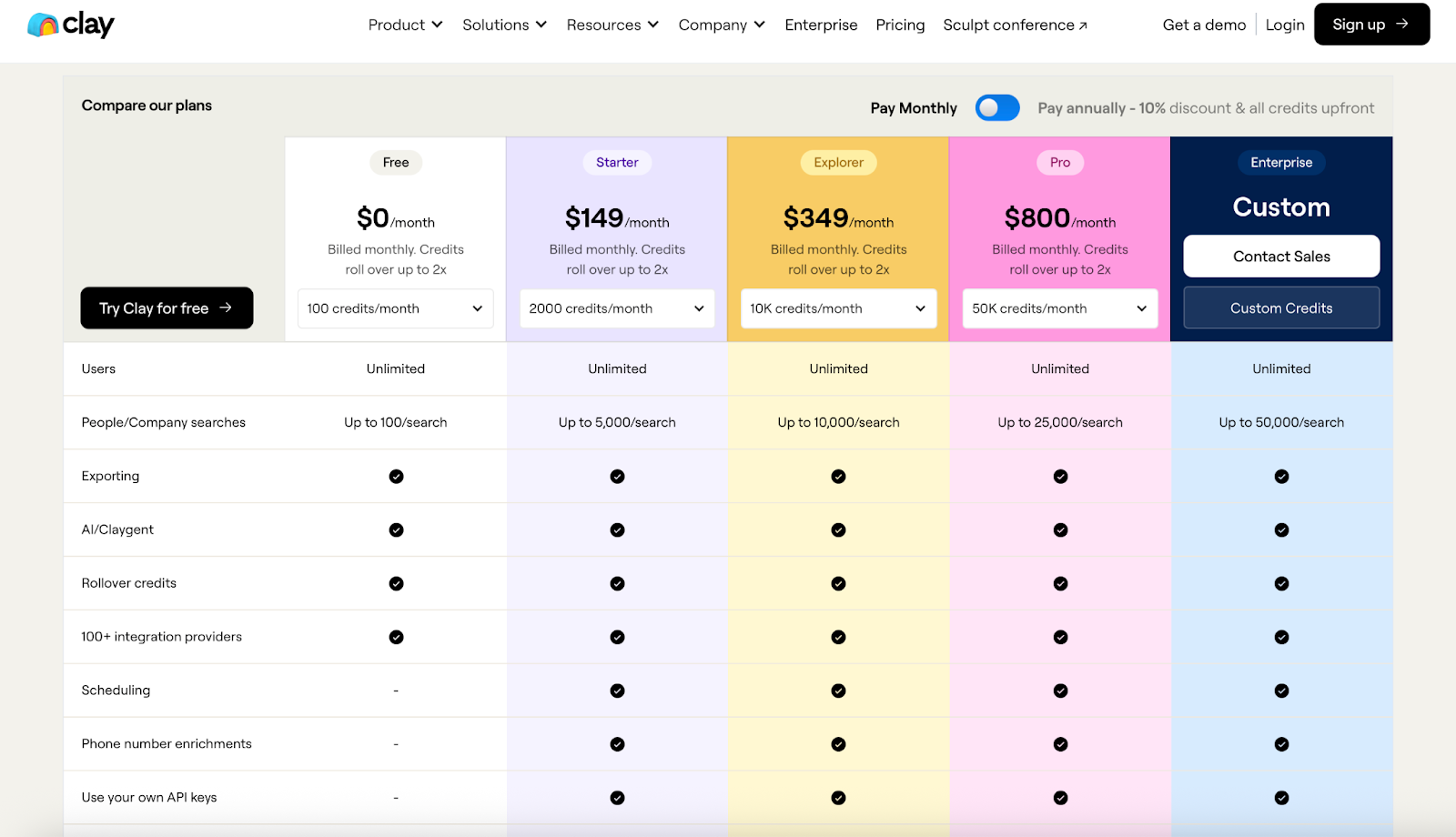Clay vs Apollo: Which one should you choose for lead generation?
While both Apollo & Clay tools are built to help you find prospects and grow your pipeline, they work in very different ways.
Apollo is known as an all-in-one platform with a built-in B2B contact database, outreach tools, and basic enrichment features.
Clay, on the other hand, is focused on deep data enrichment, intent signals, and workflow automation, helping teams personalize outreach at scale.
In this guide, I’ll break down the differences between Clay and Apollo, including features, pricing, use cases, and real-world results.
Whether you're building outbound campaigns, enriching CRM data, or trying to reduce bounce rates, this article will help you decide which tool is the better fit for your lead generation strategy.
TL;DR – Clay vs Apollo
- Apollo is an all‑in‑one sales tool with a builtin database.
A professional plan costs $99/user/month → $990/month for a 10‑person team.
Many users report outdated data, 5–10% bounce rates, and low reply rates (1–2%).
- Clay enriches leads in real time from 100+ sources.
Starter plan costs $149/month (unlimited users) + outreach tool (Salesforge) (~$80/month).
Total: about $229/month for the whole team.
Teams see <2% bounce rates and 5–8% replies, protecting domains and boosting ROI.
What is Apollo?

Apollo is an all-in-one sales platform that combines a large B2B contact database with built-in outreach tools.
It gives you access to millions of emails and phone numbers, along with features like email sequences, a dialer, CRM integrations, and basic intent filters.
You can search for leads, drop them into sequences, and start sending emails or making calls within minutes, all from the same tool.
Pricing starts at $59 per user/month, with higher plans offering more credits, mailboxes, and automation features.
On the surface, it looks like a simple and affordable solution for outbound travel.
But as you’ll see in the next sections, the real trade-off comes with data quality and deliverability.
5 Best Apollo.io Alternatives & Competitors in 2025
What is Clay?

Clay is a data enrichment platform built to help you personalize outreach at scale. Unlike Apollo, it’s not a lead database.
Instead, Clay connects to over 100 data providers and pulls fresh, accurate information about your leads, like job changes, company signals, LinkedIn data, website visits, and more.
You can create custom workflows, set rules for which leads to enrichment, and even use Clay’s AI agent (called Claygent) to research leads in real time.
It’s designed to help you figure out not just who to contact, but what to say, based on live signals and deep context.
Clay doesn’t send emails itself, but it integrates easily with outreach tools and CRMs.
Pricing starts at $149/month, and that includes unlimited users.
It’s a flexible option for teams that care about data quality, personalization, and timing.
7 Best Clay Alternatives & Competitors for Automated Outreach
Key Differences Between Clay and Apollo
Let’s go over what makes them different:
1. Where the Data Comes From
- Apollo gives you a built-in list of millions of contacts.
But many people say the data can be old or already used by others, which leads to email bounces.
- Clay doesn’t have one fixed database.
It pulls live data from lots of providers.
You can choose where the data comes from and make sure it's always up to date.
2. How Data is Enriched
- Apollo has basic enrichment.
It shows some info like job title and company size, but you can’t control much.
- Clay goes deeper.
You can add details like funding, tools used, employee count, recent activity, and even set conditions and fallback steps to make the enrichment smarter.
3. Signals and Timing
- Apollo gives some basic filters and intent topics.
- Clay lets you track things like job changes, website visits, and company news, and then take action based on those signals.
It helps you reach out at the right time.
4. Personalization
- Apollo has AI that writes emails for you, but it’s often generic.
- Clay has something called Claygent, an AI that actually researches each contact online.
It finds context from LinkedIn, websites, or news, so you can write better, more personal emails that feel human.
5. Workflows and Flexibility
- Apollo keeps everything in one system.
That’s simple, but not very flexible.
- Clay gives you full control.
You can send data into your CRM, email tool, or wherever you need.
You can also build logic: if X happens, enrich with Y, then send to Z.
It’s more powerful once you set it up.
6. Outreach
- Apollo lets you send emails, make calls, and run sequences from inside the app.
- Clay doesn’t send emails.
It works best when paired with an outreach tool, so you’re only sending to clean, verified, and enriched leads.
That means fewer bounces, fewer spam issues, and better replies.
7. Pricing
- Apollo starts at $59 per user per month, and pricing goes up as you add more users or features.
- Clay starts at $149/month total, and you pay based on how much data you enrich, not how many team members you have.
That’s a better deal for growing teams.
8. Which One Should You Use?
- Use Apollo if you want a fast, all-in-one tool and don’t mind lower data quality.
- Use Clay if you care about cleaner data, better timing, and more personalized outreach.
It takes a bit more setup, but gives you better results in the long run.
Pricing Clay vs Apollo
When comparing Clay and Apollo, it’s not just about features, the real difference shows up in cost and outcomes.
Apollo Pricing

- Apollo’s Professional plan costs $99 per user per month.
- If you have a 10-person team, you’ll spend around $990/month.
- This includes access to their database and built-in outreach tools.
It might seem affordable at first, but many users report issues with data quality, high bounce rates, and basic personalization.
So you end up paying for leads that don’t convert, and email deliverability can take a hit too.
Clay Pricing(With Outreach Layer)

- Clay’s Starter plan starts at $149/month, and that covers unlimited users.
- For outreach (email sending, sequences, etc.), you’ll need to pair it with a sending platform, like Salesforge, which will cost you around $80/month.
- Total monthly cost: around $229 for your entire team.
That means you can scale outreach without paying per user, while still getting clean data, real-time signals, and deeper personalization.
ROI Comparison: What You’re Really Paying For
So What’s the Real ROI?
Even though Clay needs an extra tool to send emails, the total cost is still much lower, and the results are better.
You get:
- Verified, fresh data instead of stale contacts
- Signals like job changes or LinkedIn activity to personalize at scale
- Fewer bounces and better inbox placement
If you care about long-term performance, not just sending more emails, the value per dollar is clearly higher with this setup.
Pros and Cons of using Clay or Apollo
If you’re trying to pick between Apollo and Clay, I’ve been in your shoes.
I’ve used both. I’ve read a ton of real reviews. And I know how it feels to waste money on tools that don’t deliver.
So here’s a simple, honest breakdown to help you choose faster.
What People Like About Apollo?
- It gives you a big B2B database with emails and phone numbers.
- You can send emails directly from Apollo, no need for extra tools.
- It’s pretty affordable if you’re just starting out.
- The setup is easy and works well for small teams.
What People Don’t Like About Apollo?
- The data is often old or wrong, leads bounce, and that kills your deliverability.
- A lot of people complain about bad support, slow replies, no chat, and no real help.

- The platform can be buggy, it freezes or crashes sometimes.
- Many users got charged for upgrades they didn’t ask for, and support didn’t fix it.
- If you're doing serious outbound, Apollo’s personalization is too basic.
What People Like About Clay?
- You get fresh, clean data pulled from many sources, not just one database.
- It finds live signals like job changes, LinkedIn activity, and more.
- You can personalize emails with real context using their AI tool (Claygent).
- It works well with other tools, like your CRM or email platform.
- You pay one flat price no matter how many people are on your team.
What People Don’t Like About Clay?

- It takes a bit of time to learn in the beginning.
- You’ll need to connect it to an email tool, it doesn’t send emails itself.
- Some people find the credit system a little confusing.
- If you're running huge lists, a few things still need manual tweaks.
So, if you just want to get started quickly and don’t care much about bounce rate or personalization, Apollo might work.
But if you want cleaner data, more replies, and better results long-term, Clay gives you more power and flexibility, especially when paired with a good outreach tool.
Why Clay Wins (Over Apollo)
Apollo makes it fast to grab leads and send emails. But fast doesn’t mean it's effective.
The real problem?
- Many users report outdated data or emails that bounce.
- High bounce rates hurt your domain.
- Poor personalization leads to fewer replies.
- And if your emails land in spam, your whole outreach slows down.
Teams using Apollo often hit bounce rates of 5–10%, with reply rates stuck at 1–2%.
That’s a lot of wasted emails, and effort.
Clay flips that.
- You start with a clean list or domain.
- Clay enriches every contact with fresh data, company size, funding, tech stack, job role, and even LinkedIn signals.
- That means every email can be relevant, timely, and personalized.
Pair that with a good sending setup, and here’s what actually happens:
- Bounce rate drops below 2%
- Reply rate goes up to 5–8%
- You avoid blacklists, protect your domain, and get more meetings booked
Clay doesn’t just give you contacts, it gives you context.
And that’s what drives better outreach.
Conclusion:
Using Apollo might seem easier at first, one tool for finding leads and sending emails.
But when the data is outdated or wrong, you end up paying in bounce rates, low replies, and lost time.
Clay takes a different route.
It builds each lead using real-time enrichment and live signals.
You don’t just get a list, you get context to send smarter emails.
Pair that with a purpose-built outreach tool like Salesforge, and you unlock a full system that:
- Protects your sending reputation
- Keeps bounces under control
- Personalizes every message
- And books more calls without burning your domain
👉 Try Salesforge with Clay and start sending better emails, not just more of them.
It's not about doing more outreach, it’s about doing it right.

.png)

.png)
.png)